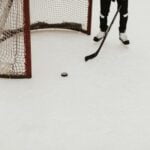Are you ready to dive into the diverse world of field hockey positions? Look no further than this comprehensive guide, titled “Exploring Field Hockey Positions: A Comprehensive Guide.” Whether you’re a beginner looking to understand the various roles on the field or a seasoned player seeking a deeper understanding of your position, this article has got you covered. As an experienced field hockey enthusiast with a background in both playing and coaching, I am excited to share my knowledge and insights to help you navigate the intricate world of field hockey positions. Join me on this journey as we explore the responsibilities, skills, and strategies involved in each position, unraveling the secrets to success on the field.

Field Hockey Positions
Field hockey is a dynamic sport that requires a deep understanding of the different positions on the field. Each position comes with its own roles and responsibilities, and players need to possess specific skills and attributes to excel in their role. In this guide, we will explore the various field hockey positions and provide insight into what it takes to succeed in each one.
Offensive Positions: Wings and Center Forward
Let’s start with the offensive side of the field. Offensive players can be categorized into three positions: left wing, right wing, and center forward. Left and right wings are responsible for creating width and stretching the opposition’s defense. They play a crucial role in attacking and creating goal-scoring opportunities for their team. The center forward, on the other hand, is the primary goal scorer. They need to have excellent shooting skills, stick skills, speed, and athleticism to outmaneuver the defenders and score goals.
“Now, while all these three positions fall under the offensive category, they do have distinct roles and responsibilities. The wings focus more on creating width and stretching the defense, whereas the center forward is the main scoring threat,” points out our field hockey expert.
Midfield Positions: The Command Center
Moving to the midfield positions, we find players who act as the link between the offensive and defensive lines. Midfielders are versatile and need to possess a wide range of skills. They are expected to be able to shoot, tackle, mark, dribble, pass, and read the play accurately. The midfielders control the tempo of the game and play a crucial role in both attacking and defending.
“The midfielders are like the conductors of an orchestra. They orchestrate the game, dictate the pace, and ensure smooth transitions between defense and attack. Their ability to read the play and make decisive passes is what separates them from the rest,” explains our expert.
Defensive Position: The Guardian of the Goal
Now, let’s focus on the defensive position. Defenders are responsible for keeping the opposition away from the goal circle. Their primary objective is to prevent the opposing team from scoring. When making a tackle as a defender, it is essential to do so outside of the goal circle to avoid any penalties.
“Our defenders are the unsung heroes of field hockey. While the offensive players get the spotlight for scoring goals, it is the defenders who protect the goal and prevent the opposition from finding the back of the net. They are the guardians of the goal,” emphasizes our expert.
Goalkeeper: The Last Line of Defense
The goalkeeper is the most unique position in field hockey. They play a critical role in keeping the other team from scoring. Unlike the other positions, goalkeepers are restricted in their movement and are the only players allowed to play the ball with their body. Their job requires quick reflexes, excellent hand-eye coordination, and strong decision-making skills.
“Our goalkeepers are the last line of defense. They are like the brick wall that stands tall, preventing any shots from getting into the net. Quick reflexes and decisive actions are what make a great goalkeeper,” enthuses our expert.
Conclusion
Understanding the different positions in field hockey is vital for players and fans alike. Each position comes with its own set of skills and responsibilities. From the offensive wings and center forward to the versatile midfielders and the defensive defenders, every position has a role to play in the game. And let’s not forget about the goalkeeper, who serves as the last line of defense. Field hockey is a sport that requires teamwork and coordination, and each position contributes to the overall success of the team.
“Remember, field hockey positions are like pieces of a puzzle. Each position has its unique role, and when they come together, they create a complete picture of a well-functioning team,” concludes our expert.
Field hockey is a sport full of fascinating history, thrilling matches, and incredible athletic feats. If you’re curious about the unique aspects of this exhilarating game, you’ll definitely want to check out these fun facts about field hockey. From the origins of the sport to its global popularity today, you’ll discover intriguing insights that will leave you amazed. So, why wait? Click here to uncover a world of captivating information about field hockey: fun facts about field hockey. Whether you’re a player, a fan, or just someone looking to expand their knowledge, you won’t be disappointed by the exciting discoveries awaiting you.
Field Hockey Positions: Finding Your Best Fit
[youtube v=”XPses7MxWmg”]
Offensive Positions: Speed, Composure, and Coordination
When considering which position is best for you on the field hockey field, it’s essential to reflect on your strengths and what comes naturally to you. The video highlights three primary offensive positions: left wing, right wing, and center forward.
Left Wing and Right Wing: These positions are typically filled by fast players who excel at running down the wings and attacking with speed. They create width and stretch the defense, opening up opportunities for goal-scoring. Additionally, players in these positions should have good hand-eye coordination for skills like tomahawks, flicks, and deflections.
“Strikers are fast players who excel at running down the wings and attacking with speed. They create width, stretch the defense, and have good hand-eye coordination for skills like tomahawks and flicks.”
Center Forward: Players in this position need to remain calm and composed when under pressure, especially when around the D. They should have excellent shooting skills with both feet and be able to accurately aim for the goal. Additionally, leading and assertiveness are crucial attributes for center forwards.
“Center forwards need to be calm and composed under pressure, have good shooting skills, and exhibit assertiveness and leadership on the field.”
The Midfield: Skills, Fitness, and Passing
The midfield acts as the link between the offensive and defensive lines. Players in this area of the field require a unique set of skills, as well as stamina and fitness to cover the entire field.
Skills in Tight Spaces: Midfielders should possess good skills when playing in tight spaces and under pressure. They need to be comfortable with close ball control and have the ability to make quick decisions while being pressed by opponents.
“Midfielders should have good skills in tight spaces, able to maintain control while under pressure from opponents.”
Fitness and Endurance: Playing in the midfield demands a high level of fitness and endurance, as these players are responsible for both attacking and defending. They need to be able to run from one 25-yard line to the other consistently throughout the game.
“Midfielders require a high level of fitness and endurance, as they need to constantly contribute to both attack and defense.”
Passing Through Lines: One of the key attributes of a great midfielder is the ability to pass through the opposition’s defensive line. It’s not just about passing to teammates but also about recognizing where they will be when the ball reaches them.
“Midfielders excel at passing through defensive lines, finding spaces to break through and create opportunities for their teammates.”
Defensive Positions: Solidity and Distribution
Defenders play a crucial role in keeping the opposition away from the goal circle and preventing goals. They are the team’s safe and solid players, with a focus on excellent basics and sound decision-making.
Defensive Skills: Defenders need to have a strong understanding of the game in order to make timely interceptions and read the play effectively. They excel at recognizing when to hold and when to apply pressure, ultimately nullifying the opposition’s attacks.
“Defenders possess a solid understanding of the game, as they need to make timely interceptions and read the play effectively.”
Distribution and Communication: Defenders are responsible for distributing the ball effectively, recognizing open spaces, and directing teammates into the right positions. Clear and effective communication is vital for a cohesive defensive unit.
“Defenders have good distribution skills, effectively communicate with teammates, and direct them to the right positions.”
Conclusion: Versatility and Adaptability Matter
While the video provides useful guidelines for identifying your ideal position, it’s essential to remember that adaptability and versatility are valuable traits for any player. Sometimes, specific positions may not suit your strengths or preferences, but being able to play different positions can make you a valuable asset to the team.
Remember, possessing a “hockey brain” and the ability to fill in where the team needs you is an important attribute.
“Versatility and adaptability are crucial qualities to have in field hockey, as being able to play in different positions makes you a valuable asset to any team.”
If you found this article helpful and want to take your game to the next level, you can apply for a free strategy session with the hockey performance Academy. Simply complete the form below or visit hockeyperformanceacademy.com/application to schedule a session.
Now that you have a better understanding of the different field hockey positions and their requirements, you can confidently choose the position that suits you best.

FAQ
Question 1:
What are the different categories of field hockey positions?
Answer 1:
Field hockey positions can be categorized into three groups: offensive, defensive, and midfield.
Question 2:
Which positions are considered offensive in field hockey?
Answer 2:
Offensive players traditionally include left and right wings and the center forward.
Question 3:
What skills are important for offensive strikers in field hockey?
Answer 3:
Offensive strikers should have good shooting skills, stick skills, speed, and athleticism.
Question 4:
What skills are required for midfield players in field hockey?
Answer 4:
Midfield players need to be able to shoot, tackle, mark, dribble, pass, and read the play accurately.
Question 5:
What makes the goalkeeper position unique in field hockey?
Answer 5:
The goalkeeper is the most unique position in field hockey as they are restricted in their movement and are the only ones allowed to play the ball with their body.














